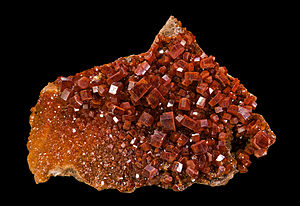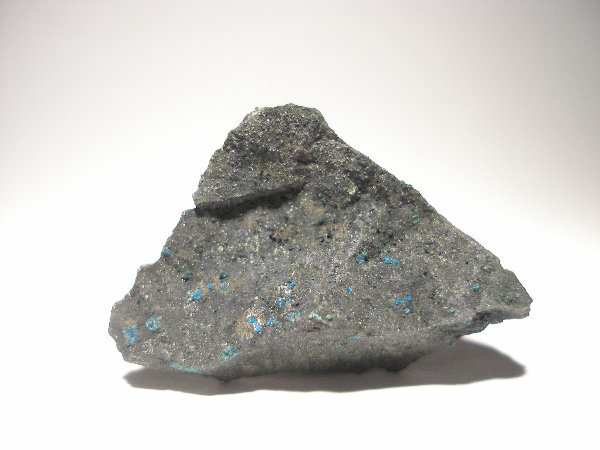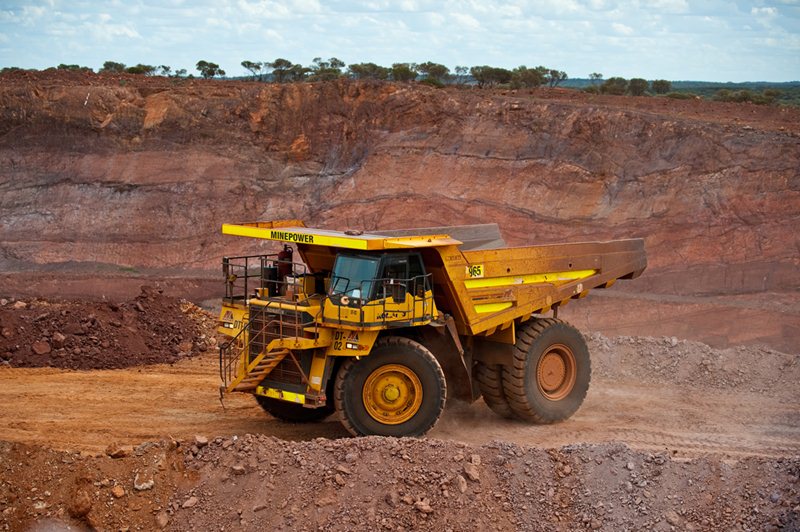Vanadium
Approximately 85% of vanadium produced is used as ferrovanadium or as a steel additive. Vanadium forms stable nitrides and carbides, resulting in a significant increase in the strength of the steel. Vanadium is compatible with iron and titanium, therefore vanadium foil is used in cladding titanium to steel. The most common oxide of vanadium, vanadium pentoxide V2O5, is used as a catalyst in manufacturing sulfuric acid by the contact process.
Metallic vanadium is not found in nature, but is known to exist in about 65 different minerals. Economically significant examples include patronite (VS4), vanadinite (Pb5(VO4)3Cl), and carnotite (K2(UO2)2(VO4)2·3H2O). Much of the world's vanadium production is sourced from vanadium-bearing magnetite found in ultramafic gabbro bodies.
Vanadinite - Pb5(VO4)3Cl
Descloizite - (Pb,Zn)2VO4OH
Blue minasragrite - (VO)2H2(SO4)3.15H2O on patronite - VS4
Source: tw.strahlen.org
Vanadium is mined mostly in South Africa, north-western China, and eastern Russia. In 2010 these three countries mined more than 98% of the 56,000 tonnes of produced vanadium.
Vanadium News
List of base metal stocks with latest financial data
| Rank | Country | World Production, By Country (Metric tons of contained vanadium) | |
|---|---|---|---|
| 1 | South Africa | 24,000 | |
| 2 | China | 19,000 | |
| 3 | Russian Federation | 14,500 | |
| 4 | Kazakhstan | 1,000 | |
Production and consumption
Both production and consumption of vanadium peaked in 2012, driven by continued growth in demand for vanadium in steel. Over 90% of vanadium is consumed as ferrovanadium in the production of steel.
Growth in vanadium demand is set to continue through 2013 and beyond, underpinned chiefly by growth in steel consumption in developing nations for construction purposes. However the precise rate of growth in vanadium consumption will be dependent on a number of factors, most notably new regulations for Chinese high-strength construction steel, which have the potential to significantly increase vanadium demand.
New design codes in China aim to restrict the use of lower strength reinforcing bars and government directives require the production of high vanadium content alternatives. This has the potential to increase China’s vanadium intensity usage rate, which currently lags those of developed countries such as the USA.
China is now the world’s largest producer of vanadium and increases in vanadium demand will, for the most part, be met by planned expansions to existing production facilities. China is in the process of significant expansion of co-product vanadium production and has added significantly to its total vanadium production capacity in 2011 and 2012 with further expansions scheduled over the next five years. Whilst production is spread across approximately 40 significant producers as well as an estimated 150 small-scale operations, volume production is dominated by Pangang Group Steel Vanadium and Titanium in Sichuan and Chengde XinXin Vanadium & Titanium Co in Hebei.
However, a number of new projects in the RoW are expected to become operational in the short term aiming to meet future increases in vanadium demand. Atlantic Ltd, which operates the Windimurra mine in Australia, started production in 2012 and is expected to produce at full capacity by the end of 2013. Largo Resources Ltd, report that production will start at its Maracás deposit in Brazil within the next year.
Increased production from these new sources is expected to keep the market in balance to 2017, although much remains dependent on prices for vanadium, which may render a wide number of producers in China and the RoW uneconomical if they fall below a certain level. (Source: http://atlanticltd.com.au/projects/windimurra )
Increased production from these new sources is expected to keep the market in balance to 2017, although much remains dependent on prices for vanadium, which may render a wide number of producers in China and the RoW uneconomical if they fall below a certain level. (Source: http://atlanticltd.com.au/projects/windimurra )
Source:http://atlanticltd.com.au/projects/windimurra



